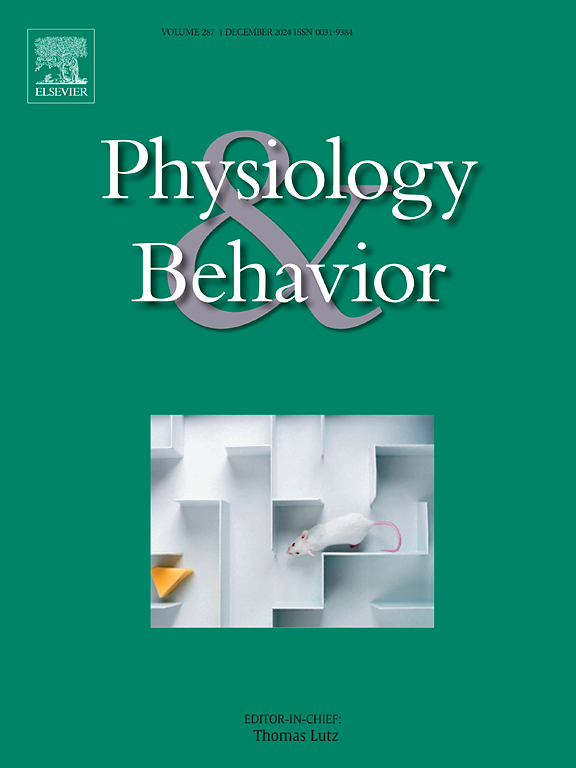Astrocytes of the hippocampus and responses to periprandial neuroendocrine hormones
IF 2.5
3区 医学
Q2 BEHAVIORAL SCIENCES
引用次数: 0
Abstract
Astrocytes have risen as stars in the field of energy homeostasis and neurocognitive function, acting as a bridge of communication between the periphery and the brain, providing metabolic support, signaling via gliotransmitters, and altering synaptic communication. Dietary factors and energy state have a profound influence on hippocampal function, and the hippocampus is critical for appropriate behavioral responses associated with feeding and internal hunger cues (being in the fasted or full state), but how the hippocampus senses periprandial status and is impacted by diet is largely unknown. Periprandial hormones act within the hippocampus to modulate processes involved in hippocampal-dependent learning and memory function and astrocytes likely play an important role in modulating this signaling. In addition to periprandial hormones, astrocytes are positioned to respond to changes in circulating nutrients like glucose. Here, we review literature investigating how astrocytes mediate changes in hippocampal function, highlighting astrocyte location, morphology, and function in the context of integrating glucose metabolism, neuroendocrine hormone action, and/or cognitive function in the hippocampus. Specifically, we discuss research findings on the effects of insulin, ghrelin, leptin, and GLP-1 on glucose homeostasis, neural activity, astrocyte function, and behavior in the hippocampus. Because obesogenic diets impact neuroendocrine hormones, astrocytes, and cognitive function, we also discuss the effects of diet and diet-induced obesity on these parameters.
海马的星形胶质细胞和对餐后神经内分泌激素的反应
星形胶质细胞已成为能量稳态和神经认知功能领域的明星,作为外周神经和大脑之间的沟通桥梁,提供代谢支持,通过胶质递质传递信号,并改变突触通讯。饮食因素和能量状态对海马功能有深远的影响,海马对进食和内部饥饿信号(禁食或饱腹状态)相关的适当行为反应至关重要,但海马如何感知餐前状态并受到饮食的影响在很大程度上是未知的。在海马体中,餐周激素调节海马依赖学习和记忆功能的过程,星形胶质细胞可能在调节这一信号传导中发挥重要作用。除了餐后激素外,星形胶质细胞还会对循环营养物质(如葡萄糖)的变化做出反应。在这里,我们回顾了有关星形胶质细胞如何介导海马功能变化的文献,强调了星形胶质细胞的位置、形态和功能在整合葡萄糖代谢、神经内分泌激素作用和/或海马认知功能的背景下。具体来说,我们讨论了胰岛素、胃饥饿素、瘦素和GLP-1对海马中葡萄糖稳态、神经活动、星形胶质细胞功能和行为的影响的研究结果。由于致肥性饮食影响神经内分泌激素、星形胶质细胞和认知功能,我们也讨论了饮食和饮食诱导的肥胖对这些参数的影响。
本文章由计算机程序翻译,如有差异,请以英文原文为准。
求助全文
约1分钟内获得全文
求助全文
来源期刊

Physiology & Behavior
医学-行为科学
CiteScore
5.70
自引率
3.40%
发文量
274
审稿时长
47 days
期刊介绍:
Physiology & Behavior is aimed at the causal physiological mechanisms of behavior and its modulation by environmental factors. The journal invites original reports in the broad area of behavioral and cognitive neuroscience, in which at least one variable is physiological and the primary emphasis and theoretical context are behavioral. The range of subjects includes behavioral neuroendocrinology, psychoneuroimmunology, learning and memory, ingestion, social behavior, and studies related to the mechanisms of psychopathology. Contemporary reviews and theoretical articles are welcomed and the Editors invite such proposals from interested authors.
 求助内容:
求助内容: 应助结果提醒方式:
应助结果提醒方式:


